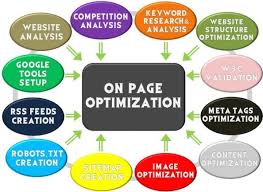What is On-Page SEO | On-Page SEO Technique - TechnicalDm
What is on-page
optimization?
- On-page optimization are also known as on site optimization.
- In on-page optimization, you optimize your website according to search engine guidelines.
- On-page optimization has effect on your website listing in natural result.
- According to latest algorithm of google panda 4.0, on page optimization play 35% role in white hat SEO.
On-page SEO technique:
All
technique mention are below.
1. Meta
title test: Meta title is a HTML tag that define your web page. The meta title
display your webpage title on search engine to appear top of the browser.
You
must include <title> tag in your web page in header section
<head>
<title>this
is my page<title>
</head>
Meta
title have character limit this under 60 character.
2. Meta
description test: Meta description is a HTML tag that define your webpage
description. Meta description provide a short and accurate summary about your
webpage. Search engine use the description to help identify your web page on
internet.
You
must include meta description tag in your web page in header section.
<head>
<meta
description name=”description” content=”this
is my website “>
</head>
Meta
description have character limit this under 160 character.
3. Most
common keyword test: check most common keyword in your website and these number
of times keyword are must be usage in your website. These can help give quick
overview of the keyword and topic that crawl associate with your web page.
4. keyword
usage test: check most keywords are used in your web page title and
description.
5. heading
tag test: check heading tag for the website that using any H1 and H2 HTML header
tag. H1 tag are represents the heading of the webpage title. The H2 tag are most
represent second heading of the web page.
6. robort.txt
test: check robort.txt file for the website. When search engine bots are crawl
a website while first access robort.txt test. Robort.txt file tell the search
engine bots to allowed to crawl on your
website pages.
7. sitemap.txt test: check if the website has a sitemap. The sitemap is most important to all listing web page of the
site and let search engine crawler to crawl the website more intelligent.
8. image
alt test: check image alt test for the website are using alt attribute. If the
image cannot displayed such as broken image source, slow internet connection
etc, image alt attribute provide alternative information of the image. Must be
use relevant keyword and text in the alt attribute.
9. Google
analytics: check your website using Google analytics. Google analytics are free
tools that help provide insight, demographics of user, your website traffic.
10. favicon
test: Check your website has favicon. Favicon are small icon that appears on
the URL browser.The favicon helps identify your brand to make it easy to user
navigate.
11. social media test: Check your website connect to
one or more social media network like a Facebook, twitter, instgram, LinkedIn.
12. social
media test: Check your website connect to one or more social media network like
a Facebook, twitter, instgram, LinkedIn.
13. HTML page size test: Check your webpage size. Your website HTML size must be under average 33kb. It can help faster loading website and improve user experience.
14. HTML compression test: Check your webpage HTML compression. Must be your website having HTML compression. It help faster loading website and improve user experience.
15. Site loading speed test: your website must be average loading speed is 5 second. It helps improve your website loading speed.
17. Java
script minification test: Check if java script file used in your webpage has
minified. Minified file can be reduce webpage size overall the load time.
18. CSS
minification test: Check if CSS file used in your webpage has minified. Minifiled
file can be reduce website size overall the load time.
19. URL
redirect test: Check how many redirect URL perform to the final URL destination.
Redirect URL can effect to search engine indexing issue.
20. URL
canonicalization test: Check your website using canonical tag. Canonical tag
are prevent to duplicate content to appear on multiple URL.
21. HTTPS
test: Check your website using HTTPS. HTTPS are secure protocol that secure your
data to sending and receiving over the
internet.



Comments
Post a Comment